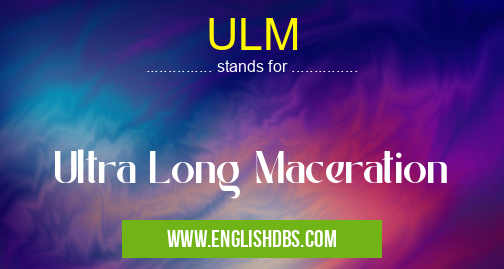What does ULM mean in UNCLASSIFIED
ULM stands for Ultra Long Maceration. It is a winemaking technique that involves macerating grape skins and seeds in the wine for an extended period of time, usually several months. This process extracts more flavor, color, and tannins from the grapes, resulting in wines with greater complexity and depth.

ULM meaning in Unclassified in Miscellaneous
ULM mostly used in an acronym Unclassified in Category Miscellaneous that means Ultra Long Maceration
Shorthand: ULM,
Full Form: Ultra Long Maceration
For more information of "Ultra Long Maceration", see the section below.
Key Characteristics of ULM
- Extended Maceration Time: ULM macerations can last for several months, even up to a year or more.
- Increased Extraction: The prolonged contact time allows for greater extraction of flavors, colors, and tannins from the grape skins and seeds.
- Enhanced Complexity: The additional compounds extracted during ULM contribute to the wine's complexity and richness.
- Stronger Tannins: Wines made with ULM tend to have higher levels of tannins, giving them a more structured and age-worthy character.
Advantages of ULM
- Increased Flavor Depth: ULM wines offer a wider range of flavors, including ripe fruit, spice, and earthy notes.
- Enhanced Texture: The extended maceration contributes to the wine's texture, making it more viscous and full-bodied.
- Improved Aging Potential: Wines made with ULM have greater aging potential due to their higher tannin content.
Essential Questions and Answers on Ultra Long Maceration in "MISCELLANEOUS»UNFILED"
What is Ultra Long Maceration (ULM)?
Ultra Long Maceration (ULM) is a winemaking technique that involves leaving the grape skins and seeds in contact with the grape juice for an extended period during fermentation, typically ranging from 30 to 100 days or more.
What are the benefits of using ULM?
ULM allows for the extraction of additional color, tannins, and flavor compounds from the grape skins and seeds, resulting in wines with greater depth, complexity, and aging potential.
How does ULM impact wine style?
Wines made using ULM tend to have bolder and more intense flavors, with higher tannin levels and a fuller body. They often exhibit aromas and flavors of ripe fruit, spice, and leather.
What grape varieties are best suited for ULM?
Red grape varieties that have thick skins and abundant tannins, such as Cabernet Sauvignon, Syrah, and Nebbiolo, are well-suited for ULM. These varieties can handle the extended maceration period without losing their freshness or structure.
What are the challenges of using ULM?
The extended maceration time increases the risk of extraction of harsh or bitter tannins, as well as the potential for microbial spoilage. Careful monitoring and management are essential to prevent these issues.
What are some notable examples of wines made using ULM?
Some renowned wines that utilize ULM include:
- Amarone della Valpolicella from Italy
- Barolo from Italy
- Taurasi from Italy
- Châteauneuf-du-Pape from France
- Opus One from California
Final Words: ULM is a winemaking technique that produces wines with exceptional complexity, depth, and aging potential. By macerating the grape skins and seeds for an extended period, ULM wines extract more flavors, colors, and tannins, resulting in a unique and sophisticated wine experience.
